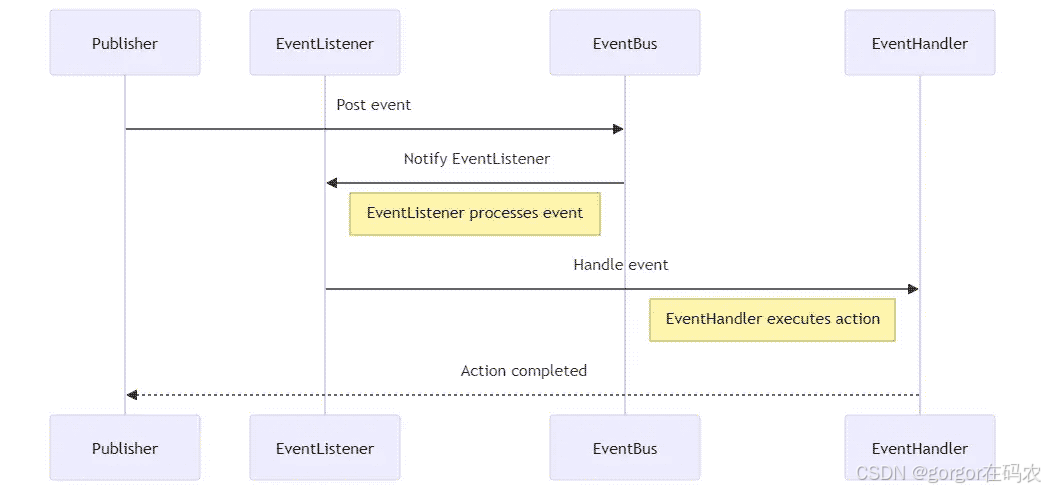Google Guava 发布订阅模式/生产消费者模式 使用详情
目录
Guava 介绍
应用场景举例
1. 引入 Maven 依赖
2. 自定义 Event 事件类
3. 定义 EventListener 事件订阅者
4. 定义 EventBus 事件总线
5. 定义 Controller 进行测试
Guava 介绍
Guava 是一组来自 Google 的核心 Java 库,里面包括新的集合 类型(例如 Multimap 和 MultiSet),不可变集合、图形库、 以及用于并发、I/O、哈希、基元、字符串,发布/订阅模式等等。接下来主要讲解 发布订阅模式。
Guava 发布订阅主要包含以下主要核心部分:
- Event 事件
- Publisher 事件发布者
- EventListener 事件订阅者
- EventBus 事件总线
工作流程:
Publisher 事件发布者 通过 EventBus 事件总线 发布事件,然后 EventBus 事件总线 把事件传给 Subscriber 事件订阅者 消费。
工作原理图:

应用场景举例
当用户注册App后,可能会产生很多行为,比如需要发短信提醒用户,注册成功,获取100积分,又或者需要给注册成功的用户送优惠卷。如果按我们平时的写法,则需要在用户注册成功后,返回请求前,需要引入发短信和发优惠卷的逻辑,不仅使冗余在注册代码中,造成耦合度太高。职责不分离。
这时就可以引入Guava 的发布订阅模式。让发送短信的监听器 和 发优惠卷的监听器 同时监听同一个事件即可。
1. 引入 Maven 依赖
<?xml version="1.0" encoding="UTF-8"?> <project xmlns="http://maven.apache.org/POM/4.0.0" xmlns:xsi="http://www.w3.org/2001/XMLSchema-instance"xsi:schemaLocation="http://maven.apache.org/POM/4.0.0 https://maven.apache.org/xsd/maven-4.0.0.xsd"><modelVersion>4.0.0</modelVersion><parent><groupId>org.springframework.boot</groupId><artifactId>spring-boot-starter-parent</artifactId><version>2.2.1.RELEASE</version></parent><groupId>com.xinxin</groupId><artifactId>cyh</artifactId><version>0.0.1-SNAPSHOT</version><properties><java.version>1.8</java.version></properties><dependencies><dependency><groupId>org.springframework.boot</groupId><artifactId>spring-boot-starter-web</artifactId></dependency><dependency><groupId>org.projectlombok</groupId><artifactId>lombok</artifactId></dependency><dependency><groupId>com.google.guava</groupId><artifactId>guava</artifactId><version>19.0</version></dependency><dependency><groupId>com.alibaba</groupId><artifactId>fastjson</artifactId><version>1.2.70</version></dependency></dependencies> </project>
2. 自定义 Event 事件类
Event 类是我们生产者和消费者 消息传播的载体,也就是发送的内容,通常我们以 Event 为后缀来命名事件类。
import lombok.AllArgsConstructor;
import lombok.Data;
import lombok.NoArgsConstructor;import java.util.Date;/*** @description: 用户注册事件* @author: cyh* @create: 2024-11-02 17:07**/
@AllArgsConstructor
@NoArgsConstructor
@Data
public class UserRegisterEvent {private Long userId;private Date registerTime;
}
3. 定义 EventListener 事件订阅者
事件订阅者即事件的监听者,接受事件消费的一端。监听者会一直监听他们所关注的事件。
事件订阅者的定义,需要在方法上添加@Subscribe注解声明自己为事件订阅者,然后方法参数是他们监控的 Event 事件。
一般@Subscribe可以配合@AllowConcurrentEvents注解一起使用,这个注解是用来标识当前订阅者是线程安全的,可以减少同步开销。
3.1 定义 发送短信 事件订阅者
/*** @description: 短信事件监听器* @author: cyh* @create: 2024-11-02 17:10**/
@Slf4j
@Component
public class SmsEventListener {@Subscribe@AllowConcurrentEventspublic void recordRegisterLog(UserRegisterEvent event) {Long userId = event.getUserId();Date registerTime = event.getRegisterTime();log.info("短信监听器 监听到用户注册行为,用户 {} 在 {} 注册成功,事件内容为:{}", userId, registerTime, JSON.toJSONString(event));//发送短信通知log.info("发送短信通知");}}3.2 定义 发送优惠卷 事件订阅者
/*** @description: 优惠卷事件监听器* @author: cyh* @create: 2024-11-02 17:10**/
@Slf4j
@Component
public class CouponEventListener {@Subscribe@AllowConcurrentEventspublic void recordRegisterLog(UserRegisterEvent event) {Long userId = event.getUserId();Date registerTime = event.getRegisterTime();log.info("优惠卷监听器 监听到用户注册行为,用户 {} 在 {} 注册成功,事件内容为:{}", userId, registerTime, JSON.toJSONString(event));//发送优惠卷log.info("发送优惠卷");}
}4. 定义 EventBus 事件总线
EventBus 事件总线的作用是,将 Event 事件 转发给 EventListener 事件订阅者。所以 首先我们就要把 事件订阅者注册给总线,它才知道有哪些订阅者需要转发。 然后将不同的 Event 事件 转发给订阅了该事件的订阅者。
事件总线有两个作用:
- 发布消息
- 转发消息给订阅者
4.1 EventBus 事件总线,代码定义
/*** @description: 事件总线* @author: cyh* @create: 2024-11-02 17:16**/
@Slf4j
@Component
public class EventBusCenter {private static EventBus eventBus;private static AsyncEventBus asyncEventBus;private static Executor executor = new ThreadPoolExecutor(12, 12, 60,TimeUnit.SECONDS, new LinkedBlockingQueue<Runnable>(100000), Executors.defaultThreadFactory(), new ThreadPoolExecutor.CallerRunsPolicy());/*** 异步事件单例模式* @return*/private static synchronized AsyncEventBus getAsyncEventBus() {if(asyncEventBus == null){asyncEventBus = new AsyncEventBus(executor);}return asyncEventBus;}/*** 同步事件单例模式* @return*/private static synchronized EventBus getEventBus() {if(eventBus == null) {eventBus = new EventBus();}return eventBus;}public static void register(Object object) {getEventBus().register(object);getAsyncEventBus().register(object);}public static void unregister(Object object) {getEventBus().unregister(object);getAsyncEventBus().unregister(object);}/*** 同步发送事件* @param event*/public static void post(Object event) {log.info("同步发送事件内容:{}", JSON.toJSONString(event));eventBus.post(event);}/*** 异步发送事件* @param event*/public static void asyncPost(Object event) {log.info("异步发送事件内容:{}", JSON.toJSONString(event));asyncEventBus.post(event);}
}
4.2 将 EventListener 事件订阅者注册到总线中
@Order(1)
@Slf4j
@Component
@Configuration
public class RegisterListenerToBus implements ApplicationListener<ApplicationReadyEvent> {@Resourceprivate SmsEventListener smsEventListener;@Resourceprivate CouponEventListener couponEventListener;@Overridepublic void onApplicationEvent(ApplicationReadyEvent event) {log.info("ApplicationReadyEvent init restTemplate.");try {//监听器注册EventBusCenter.register(smsEventListener);EventBusCenter.register(couponEventListener);} catch (Exception e) {log.error("初始化配置失败!", e);}log.info("ApplicationReadyEvent init restTemplates finished.");}}5. 定义 Controller 进行测试
/*** @description:* @author: cyh* @create: 2024-11-02 17:28**/
@RestController
public class RegisterController {@GetMapping("/register")public String register(Long userId){UserRegisterEvent event = new UserRegisterEvent(userId, new Date());//同步发送EventBusCenter.post(event);
// //异步发送
// EventBusCenter.asyncPost(event);return "ok";}
}测试结果
同步发送事件内容:{"registerTime":1730557363231,"userId":1594}
短信监听器 监听到用户注册行为,用户 1594 在 Sat Nov 02 22:22:43 CST 2024 注册成功,事件内容为:{"registerTime":1730557363231,"userId":1594}
发送短信通知
优惠卷监听器 监听到用户注册行为,用户 1594 在 Sat Nov 02 22:22:43 CST 2024 注册成功,事件内容为:{"registerTime":1730557363231,"userId":1594}
发送优惠卷